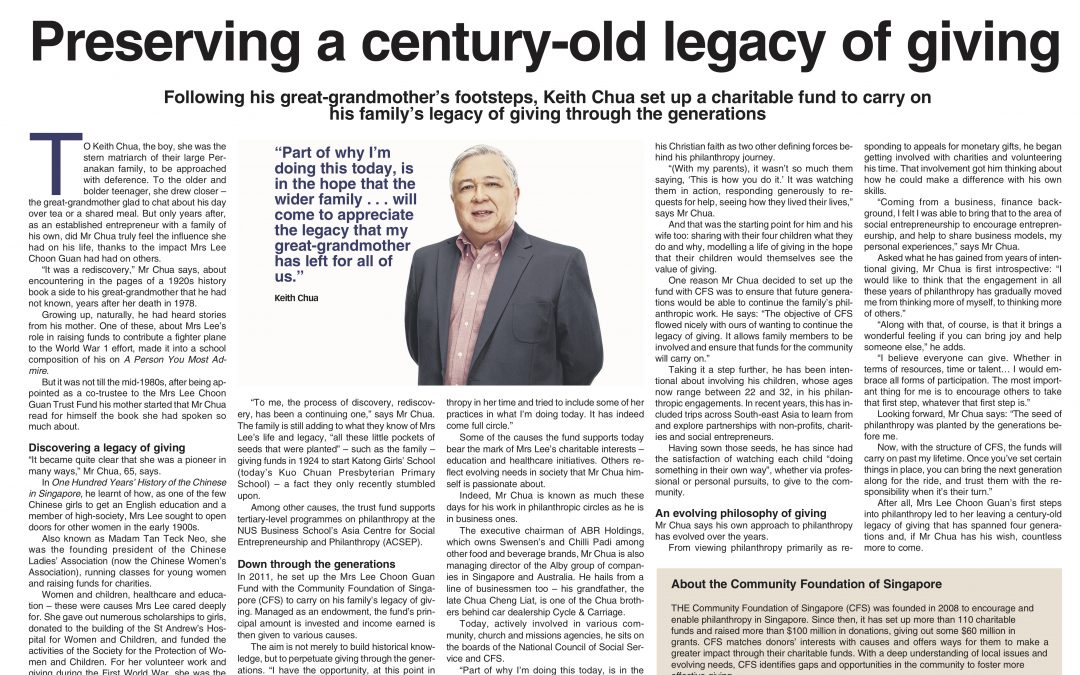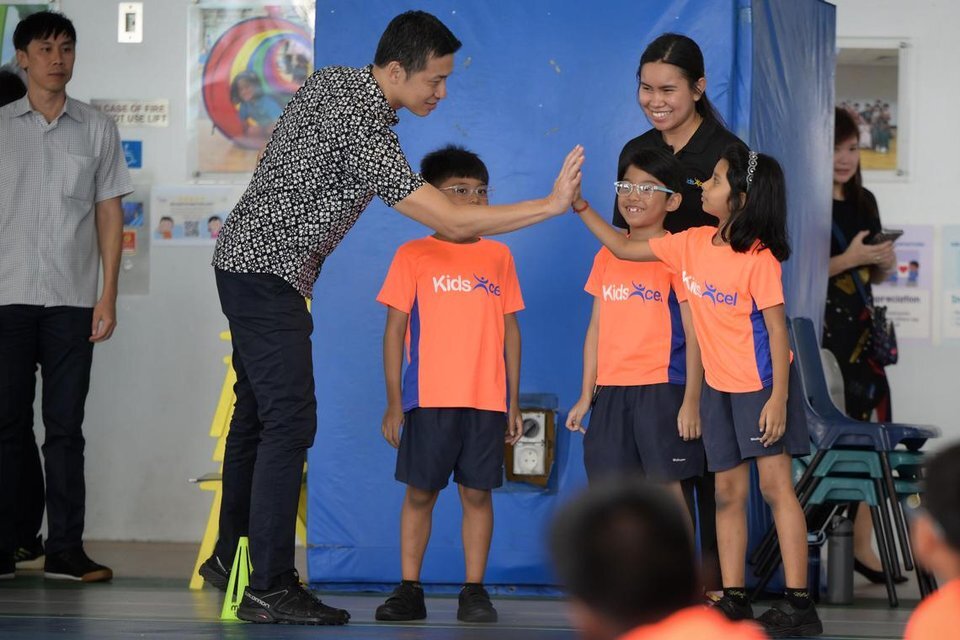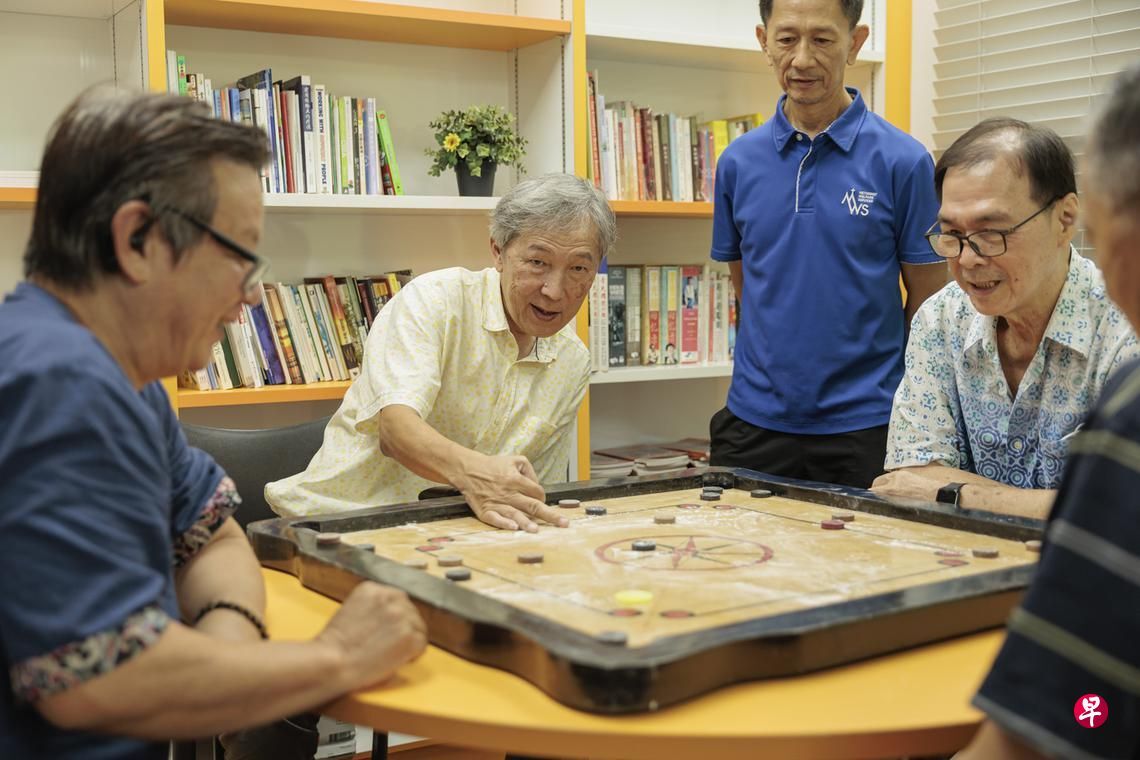Business Times: Preserving a century-old legacy of giving


Following his great-grandmother’s footsteps, Keith Chua set up a charitable fund to carry on his family’s legacy of giving through the generations.
To Keith Chua, the boy, she was the stern matriarch of their large, Peranakan family, to be approached with deference. To the older and bolder teenager, she drew closer – the great-grandmother glad to chat about his day over tea or a shared meal.
But only years after, as an established entrepreneur with a family of his own, did Mr Chua truly feel the impact of her life on his own, thanks to the impact Mrs Lee Choon Guan had had on others.
“It was a rediscovery,” Mr Chua says, about encountering in the pages of a 1920s history book a side to his great-grandmother that he had not known, years after her death in 1978.
Growing up, naturally, he had heard stories from his mother. One of these, about Mrs Lee’s role in raising funds to contribute a fighter plane to the World War 1 effort, made it into a school composition of his on “A Person You Most Admire”.
But it was not till the mid-1980s, after being appointed as a co-trustee to the Mrs Lee Choon Guan Trust Fund his mother started that Mr Chua read for himself the book she had spoken so much about.
Discovering a legacy of giving
“It became quite clear that she was a pioneer in many ways,” Mr Chua, 65, says.
In One Hundred Years’ History of the Chinese in Singapore, he learnt of how, as one of the few Chinese girls to get an English education and a member of high-society, Mrs Lee sought to open doors for other women in the early 1900s.
Also known as Madam Tan Teck Neo, she was the founding president of the Chinese Ladies Association (now the Chinese Women’s Association), running classes for young women and raising funds for charities.
Women and children, healthcare and education – these were causes Mrs Lee cared deeply for. She gave out numerous scholarships to girls, donated to the building of the St Andrew’s Hospital for Women and Children, and funded the activities of the Society for the Protection of Women and Children. For her volunteer work and giving during the First World War, she was the first Chinese woman to be made a Member of the Order of the British Empire in 1918.
Moved by the glimpses of her trailblazing giving recorded in the book, Mr Chua has since acquired an autographed edition that is now a treasured possession for what it symbolises – a legacy of giving to be kept alive.
“To me, the process of discovery, rediscovery, has been a continuing one,” says Mr Chua. The family is still adding to what they know of Mrs Lee’s life and legacy, “all these little pockets of seeds that were planted”. Such as the family giving funds in 1924 to start Katong Girls’ School (today’s Kuo Chuan Presbyterian Primary School) – a fact they only recently stumbled upon.
Among other causes, the trust fund supports tertiary-level programmes on philanthropy at the NUS Business School’s Asia Centre for Social Entrepreneurship and Philanthropy (ACSEP).
Down through the generations
In 2011, he set up the Mrs Lee Choon Guan Fund with the Community Foundation of Singapore (CFS) to carry on his family’s legacy of giving through the generations. Managed as an endowment, the fund’s principal amount is invested and income earned is then given to various causes.
The aim is not merely to build historical knowledge, but to perpetuate the legacy of giving. “I have the opportunity, at this point in time, to put some thought and action into encouraging the continuation of her legacy. So that, hopefully, it will continue with some degree of active participation by future generations,” says Mr Chua.
“In continuing the legacy of my great-grandmother, I looked at how she approached philanthropy in her time and tried to include some of her practices in what I’m doing today. It has indeed come full circle.”
Some of the causes the fund supports today bear the mark of Mrs Lee’s charitable interests – education and healthcare initiatives. Others reflect evolving needs in society that Mr Chua himself is passionate about.
Indeed, Mr Chua is known as much these days for his work in philanthropic circles as he is in business ones.
The executive chairman of ABR Holdings, which owns Swensen’s and Chilli Padi among other food and beverage brands, Mr Chua is also managing director of the Alby group of companies in Singapore and Australia. He hails from a line of businessmen too – his grandfather, the late Chua Cheng Liat, is one of the Chua brothers behind car dealership Cycle & Carriage.
Today, actively involved in various community, church and missions agencies, he sits on the boards of the National Council of Social Service and CFS.
“Part of why I’m doing this today, is in the hope that the wider family, beyond just my siblings and children through to my cousins, my nephews and nieces, and their children, will come to appreciate the legacy that my great-grandmother has left for all of us.”
Apart from his great-grandmother, Mr Chua cites the influence of his parents’ generosity and his Christian faith as two other defining forces behind his philanthropy journey.
“[With my parents], it wasn’t so much them saying, ‘This is how you do it.’ It was watching them in action, responding generously to requests for help, seeing how they lived their lives,” says Mr Chua.
And that was the starting point for him and his wife too: sharing with their four children what they do and why, modelling a life of giving in the hope that their children would themselves see the value of giving.
One reason Mr Chua decided to set up the fund with CFS was to ensure that future generations would be able to continue the family’s philanthropic work. He says, “The objective of CFS flowed nicely with ours of wanting to continue the legacy of giving. It allows family members to be involved and ensure that funds for the community will carry on.”
Taking it a step further, he has been intentional about involving his children, whose ages now range between 22 and 32, in his philanthropic engagements. In recent years, this has included trips across Southeast Asia to learn from and explore partnerships with non-profits, charities and social entrepreneurs.
Having sown those seeds, he has since had the satisfaction of watching each child “doing something in their own way”, whether via professional or personal pursuits, to give to the community.
An evolving philosophy of giving
Mr Chua says his own approach to philanthropy has evolved over the years.
From viewing philanthropy primarily as responding to appeals for monetary gifts, he began getting involved with charities and volunteering his time. That involvement got him thinking about how he could make a difference with his own skills.
“Coming from a business, finance background, I felt I was able to bring that to the area of social entrepreneurship to encourage entrepreneurship, and help to share business models, my personal experiences,” says Mr Chua.
Asked what he has gained from years of intentional giving, Mr Chua is first introspective: “I would like to think that the engagement in all these years of philanthropy has gradually moved me from thinking more of myself, to thinking more of others.”
“Along with that, of course, is that it brings a wonderful feeling if you can bring joy and help someone else,” he adds.
“I believe everyone can give. Whether in terms of resources, time or talent… I would embrace all forms of participation. The most important thing for me is to encourage others to take that first step, whatever that first step is.”
Looking forward, Mr Chua says, “The seed of philanthropy was planted by the generations before me. Now, with the structure of CFS, the funds will carry on past my lifetime. Once you’ve set certain things in place, you can bring the next generation along for the ride, and trust them with the responsibility when it’s their turn.”
After all, Mrs Lee Choon Guan’s first steps into philanthropy led to her leaving a century-old legacy of giving that has spanned four generations and, if Mr Chua has his wish, countless more to come.
Source: Business Times © Singapore Press Holdings Limited. Permission required for reproduction.
Following his great-grandmother’s footsteps, Keith Chua set up a charitable fund to carry on his family’s legacy of giving through the generations.
To Keith Chua, the boy, she was the stern matriarch of their large, Peranakan family, to be approached with deference. To the older and bolder teenager, she drew closer – the great-grandmother glad to chat about his day over tea or a shared meal.
But only years after, as an established entrepreneur with a family of his own, did Mr Chua truly feel the impact of her life on his own, thanks to the impact Mrs Lee Choon Guan had had on others.
“It was a rediscovery,” Mr Chua says, about encountering in the pages of a 1920s history book a side to his great-grandmother that he had not known, years after her death in 1978.
Growing up, naturally, he had heard stories from his mother. One of these, about Mrs Lee’s role in raising funds to contribute a fighter plane to the World War 1 effort, made it into a school composition of his on “A Person You Most Admire”.
But it was not till the mid-1980s, after being appointed as a co-trustee to the Mrs Lee Choon Guan Trust Fund his mother started that Mr Chua read for himself the book she had spoken so much about.
Discovering a legacy of giving
“It became quite clear that she was a pioneer in many ways,” Mr Chua, 65, says.
In One Hundred Years’ History of the Chinese in Singapore, he learnt of how, as one of the few Chinese girls to get an English education and a member of high-society, Mrs Lee sought to open doors for other women in the early 1900s.
Also known as Madam Tan Teck Neo, she was the founding president of the Chinese Ladies Association (now the Chinese Women’s Association), running classes for young women and raising funds for charities.
Women and children, healthcare and education – these were causes Mrs Lee cared deeply for. She gave out numerous scholarships to girls, donated to the building of the St Andrew’s Hospital for Women and Children, and funded the activities of the Society for the Protection of Women and Children. For her volunteer work and giving during the First World War, she was the first Chinese woman to be made a Member of the Order of the British Empire in 1918.
Moved by the glimpses of her trailblazing giving recorded in the book, Mr Chua has since acquired an autographed edition that is now a treasured possession for what it symbolises – a legacy of giving to be kept alive.
“To me, the process of discovery, rediscovery, has been a continuing one,” says Mr Chua. The family is still adding to what they know of Mrs Lee’s life and legacy, “all these little pockets of seeds that were planted”. Such as the family giving funds in 1924 to start Katong Girls’ School (today’s Kuo Chuan Presbyterian Primary School) – a fact they only recently stumbled upon.
Among other causes, the trust fund supports tertiary-level programmes on philanthropy at the NUS Business School’s Asia Centre for Social Entrepreneurship and Philanthropy (ACSEP).
Down through the generations
In 2011, he set up the Mrs Lee Choon Guan Fund with the Community Foundation of Singapore (CFS) to carry on his family’s legacy of giving through the generations. Managed as an endowment, the fund’s principal amount is invested and income earned is then given to various causes.
The aim is not merely to build historical knowledge, but to perpetuate the legacy of giving. “I have the opportunity, at this point in time, to put some thought and action into encouraging the continuation of her legacy. So that, hopefully, it will continue with some degree of active participation by future generations,” says Mr Chua.
“In continuing the legacy of my great-grandmother, I looked at how she approached philanthropy in her time and tried to include some of her practices in what I’m doing today. It has indeed come full circle.”
Some of the causes the fund supports today bear the mark of Mrs Lee’s charitable interests – education and healthcare initiatives. Others reflect evolving needs in society that Mr Chua himself is passionate about.
Indeed, Mr Chua is known as much these days for his work in philanthropic circles as he is in business ones.
The executive chairman of ABR Holdings, which owns Swensen’s and Chilli Padi among other food and beverage brands, Mr Chua is also managing director of the Alby group of companies in Singapore and Australia. He hails from a line of businessmen too – his grandfather, the late Chua Cheng Liat, is one of the Chua brothers behind car dealership Cycle & Carriage.
Today, actively involved in various community, church and missions agencies, he sits on the boards of the National Council of Social Service and CFS.
“Part of why I’m doing this today, is in the hope that the wider family, beyond just my siblings and children through to my cousins, my nephews and nieces, and their children, will come to appreciate the legacy that my great-grandmother has left for all of us.”
Apart from his great-grandmother, Mr Chua cites the influence of his parents’ generosity and his Christian faith as two other defining forces behind his philanthropy journey.
“[With my parents], it wasn’t so much them saying, ‘This is how you do it.’ It was watching them in action, responding generously to requests for help, seeing how they lived their lives,” says Mr Chua.
And that was the starting point for him and his wife too: sharing with their four children what they do and why, modelling a life of giving in the hope that their children would themselves see the value of giving.
One reason Mr Chua decided to set up the fund with CFS was to ensure that future generations would be able to continue the family’s philanthropic work. He says, “The objective of CFS flowed nicely with ours of wanting to continue the legacy of giving. It allows family members to be involved and ensure that funds for the community will carry on.”
Taking it a step further, he has been intentional about involving his children, whose ages now range between 22 and 32, in his philanthropic engagements. In recent years, this has included trips across Southeast Asia to learn from and explore partnerships with non-profits, charities and social entrepreneurs.
Having sown those seeds, he has since had the satisfaction of watching each child “doing something in their own way”, whether via professional or personal pursuits, to give to the community.
An evolving philosophy of giving
Mr Chua says his own approach to philanthropy has evolved over the years.
From viewing philanthropy primarily as responding to appeals for monetary gifts, he began getting involved with charities and volunteering his time. That involvement got him thinking about how he could make a difference with his own skills.
“Coming from a business, finance background, I felt I was able to bring that to the area of social entrepreneurship to encourage entrepreneurship, and help to share business models, my personal experiences,” says Mr Chua.
Asked what he has gained from years of intentional giving, Mr Chua is first introspective: “I would like to think that the engagement in all these years of philanthropy has gradually moved me from thinking more of myself, to thinking more of others.”
“Along with that, of course, is that it brings a wonderful feeling if you can bring joy and help someone else,” he adds.
“I believe everyone can give. Whether in terms of resources, time or talent… I would embrace all forms of participation. The most important thing for me is to encourage others to take that first step, whatever that first step is.”
Looking forward, Mr Chua says, “The seed of philanthropy was planted by the generations before me. Now, with the structure of CFS, the funds will carry on past my lifetime. Once you’ve set certain things in place, you can bring the next generation along for the ride, and trust them with the responsibility when it’s their turn.”
After all, Mrs Lee Choon Guan’s first steps into philanthropy led to her leaving a century-old legacy of giving that has spanned four generations and, if Mr Chua has his wish, countless more to come.
Source: Business Times © Singapore Press Holdings Limited. Permission required for reproduction.
- Related Topics For You: ACCESSING QUALITY EDUCATION, CHARITY STORIES, CHILDREN, DONOR STORIES, DONOR-ADVISED FUND, EDUCATION, HEALTH, INCLUSIVITY & INTEGRATION, LEGACY GIVING, NEWS, PROMOTING HEALTHCARE, STORIES OF IMPACT
.jpg)


